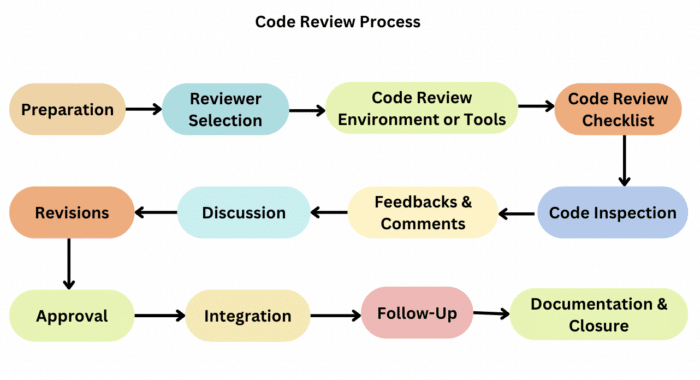Navigating the world of code reviews can feel like charting a course through uncharted waters, but it doesn’t have to be. By setting clear review guidelines, you ensure everyone understands the standards and expectations.
Automating routine checks with tools like linters and static analysis saves time and catches common errors early.
Constructive feedback that highlights strengths and suggests improvements fosters a positive learning environment.
Encouraging peer reviews brings diverse perspectives and promotes knowledge sharing.
Lastly, leveraging review tools effectively streamlines the process and enhances collaboration.
Ready to optimize your team’s workflow? Here’s how.
Set Clear Review Guidelines
To make your code reviews efficient and effective, set clear guidelines that outline expectations and best practices for both reviewers and submitters.
Begin by defining code standards, specifying acceptable comment formats, and setting review timelines. Everyone should understand what constitutes quality code and the value of constructive feedback.
First, establish code standards. These standards serve as a benchmark for what’s considered good code within your team.
They should cover aspects such as naming conventions, code structure, and documentation requirements. Clear standards help maintain consistency and make it easier for reviewers to identify issues.
Next, specify acceptable comment formats. Comments should be clear and helpful, pointing out not just what needs to be changed but also why.
For example, instead of saying, ‘This function is too long,’ a more helpful comment would be, ‘Consider breaking this function into smaller parts to make it easier to read and maintain.’
Also, set review timelines to ensure that feedback is timely and that the review process doesn’t become a bottleneck. Timely reviews help keep projects on track and allow developers to make necessary changes without significant delays.
Everyone involved in the review process should understand the importance of constructive feedback.
Constructive feedback focuses on improvement and helps the submitter understand what needs to be changed and why. It’s about fostering a positive environment where everyone is encouraged to learn and grow.
Automate Routine Checks

Automate routine checks by integrating linters, static analysis tools, and automated tests into your development workflow. These tools help catch common errors, enforce coding standards, and identify potential issues early.
By automating these checks, you save time and can focus on more critical parts of the code review. This approach ensures higher code quality and efficiency. It’s a straightforward way to streamline your review process.
Linters are tools that analyze your code for stylistic and programming errors. They help maintain consistent coding standards across your project.
For instance, a linter can flag unused variables or improper indentation, which helps keep your code clean and readable.
Static analysis tools go a step further by examining your code without executing it. These tools can detect security vulnerabilities, performance issues, and other potential bugs.
For example, they can identify memory leaks or null pointer dereferences, which mightn’t be obvious during manual reviews.
Automated tests run predefined tests on your code to ensure it behaves as expected. These tests can range from unit tests, which check individual functions, to integration tests that verify how different parts of your application work together.
By running these tests automatically, you can quickly catch regressions or new issues introduced by recent changes.
Incorporating these tools into your workflow is practical and straightforward. Start by setting up a continuous integration (CI) system that automatically runs these checks whenever you push new code.
This ensures that every change is verified against your standards before being merged into the main codebase.
Imagine you’re working on a large project with multiple contributors. Without automated checks, each contributor would have to manually ensure their code meets the project’s standards, which is time-consuming and error-prone.
Automating this process not only saves time but also ensures consistency and reliability across your project.
Provide Constructive Feedback
After automating routine checks, it’s crucial to focus on providing constructive feedback to help your team grow and improve. Highlight both strengths and areas for improvement, using specific examples to illustrate your points.
Be clear, concise, and respectful. Instead of merely pointing out flaws, offer solutions or alternatives. This approach fosters a positive learning environment, encouraging continuous development and better coding practices.
When giving feedback, start by acknowledging the team’s strengths. For example, if a team member writes clean, efficient code, mention how their work contributes to the project’s success.
This positive reinforcement builds confidence and motivates them to maintain high standards.
Next, address areas needing improvement. Be specific about what needs to change and why. For instance, if a piece of code lacks proper documentation, explain how adding comments can make future maintenance easier for everyone.
This clarity helps the team understand the importance of the change and how it benefits the project.
Providing solutions is also essential. Instead of just saying a method is inefficient, suggest an alternative approach. For example, if a loop can be optimized, explain how a different algorithm could improve performance.
Offering practical advice shows you’re invested in their development and not just critiquing their work.
Always maintain a respectful tone. Constructive feedback should never feel like a personal attack. Focus on the work, not the person. This distinction helps create a safe space where team members feel comfortable receiving and acting on feedback.
Encourage Peer Reviews

Encouraging peer reviews improves code quality and fosters a collaborative team culture. By involving teammates in code reviews, you gain various perspectives, which helps catch potential issues early.
This practice promotes knowledge sharing and continuous learning, ensuring everyone improves their skills. It also builds trust and camaraderie among team members, making the development process more cohesive and efficient.
When team members review each other’s code, they bring different experiences and insights.
This diversity in thought can identify errors or suggest enhancements that might be overlooked by a single developer. It’s a way to ensure that the code meets high standards and follows best practices.
Additionally, peer reviews act as a learning tool. Junior developers can learn from more experienced colleagues, while seasoned developers might pick up new techniques or understand different approaches.
This exchange of knowledge is invaluable for professional growth and keeps the team’s skills sharp.
Moreover, the process of reviewing code together helps build a sense of trust within the team. When everyone is involved in maintaining the quality of the project, there’s a shared responsibility and accountability.
This collective effort strengthens team bonds and makes the work environment more cohesive.
Use Review Tools Effectively
Using review tools efficiently can streamline the code review process and boost productivity. Leverage features such as inline comments, automated checks, and version control integration.
These tools help pinpoint issues quickly and ensure consistency across the codebase. Customize settings to fit your team’s workflow for optimal results.
By mastering these tools, you’ll make code reviews faster, more thorough, and ultimately more beneficial.
Inline comments allow reviewers to provide specific feedback directly within the code. This method makes it easier to understand the context of the comments and address issues accurately.
Automated checks, such as linting and unit tests, can catch common errors before a human reviewer even looks at the code. This not only saves time but also improves code quality.
Version control integration is another essential feature. It helps track changes, making it easier to see what’s been modified, added, or removed.
This can be especially useful for large projects with multiple contributors. Ensure that everyone on the team is familiar with these tools and understands how to use them effectively.
Customizing tool settings can further enhance your workflow. Different teams have different needs, and what works for one may not work for another.
Take the time to adjust settings to match your team’s specific requirements. This may include setting up specific automated checks or customizing notification settings to ensure that everyone stays informed.


















